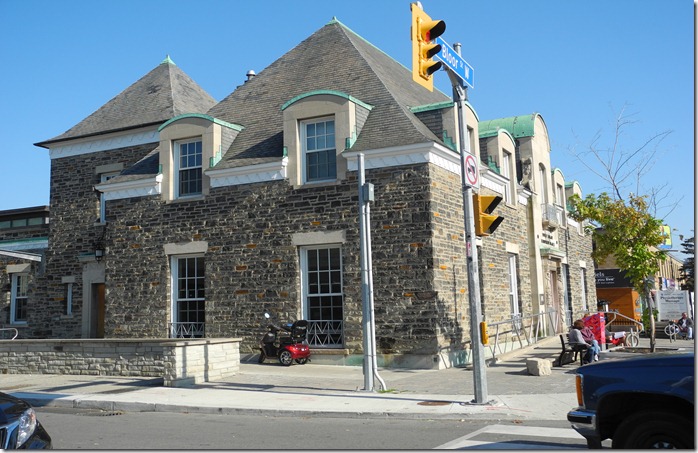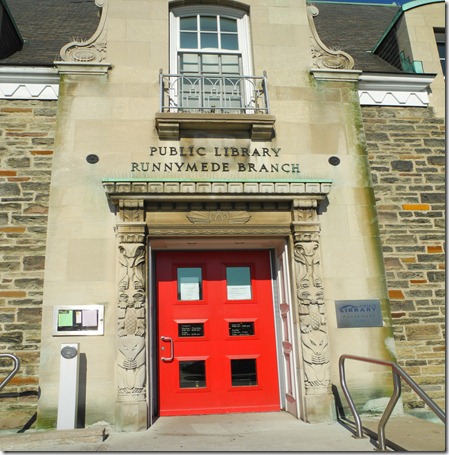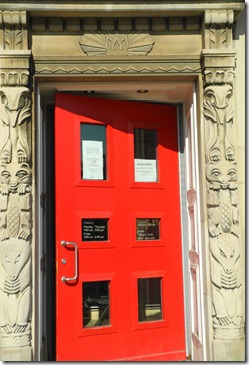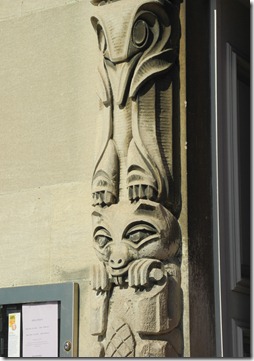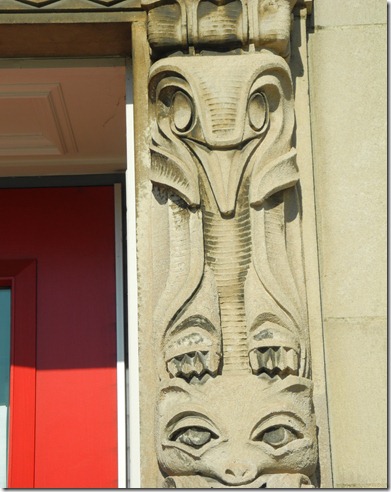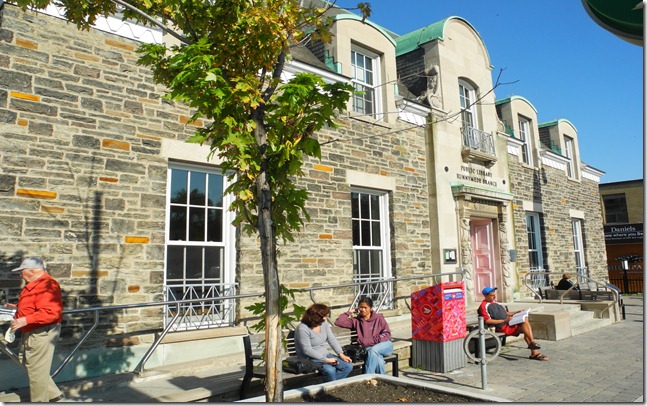The Runnymede Public Library at 2178 Bloor Street, east of Runnymede Road, is one of the few libraries to be immortalized on a stamp issued by Canada Post. The ornate stone structure is deserving of recognition, as it is one of the most attractive buildings owned by the Toronto Public Library and an architectural icon of the city. It is also an important and integral part of the Bloor West Village.
This photo from the City of Toronto Archives of the Runnymede Library was taken in 1930.
The Runnymede Library today.This photo depicts the west facade of the building, facing Glendonwyne Avenue, and the south facade facade on Bloor Street West. The iron fence from the 1929 library has disappeared, and a wheelchair ramp has been added.
The Runnymede Library, whose architect was John M. Lyle, opened in 1929. Lyle also designed Toronto’s new Union Station, which was officially opened in 1927, as well as the 1497-seat Royal Alexander Theatre, which commenced stage performances in 1907, and the impressive headquarters of the Bank of Nova Scotia at King and Bay Streets. Lyle was born in Ireland in 1872, but spent his childhood in Hamilton, Ontario. He studied at Yale University and in Paris. He commenced his career in New York City, but returned to Canada in 1905, and lived in Toronto. He is often referred to as a “progressive traditionalist,” as he combined the best of the traditional architectural styles, but included modern motives that combined English, French, and Aboriginal traditions. The Runnymede Library is one of the best examples of a building that includes these three traditions. Lyle greatly promoted Beaux Arts Classicism.
The walls of the two-storey Runnymede Library are constructed of rough, highly textured stone from the Credit River Valley. The steep black-slate roof and gabled windows are reminiscent of French Canadian architecture. The four gables that face Bloor Street break the roof line on the south side. The doorway has carved-stone totem poles and other Native Peoples’ motifs. Since the library opened in 1929, it has been expanded to the north, but Lyle’s original design has never been compromised.
The impressive main doorway to the library, the red door surrounded by Native People’s designs. The window above the door, with its iron railing, is inserted into an ornate gable.
Designs surrounding the doorway, which include totems that contain stylized ravens, bears and beavers.
Close-up view of the doorway totems.
The south facade of the Runnymede Library, the space in front of the building an inviting place to relax on a summer day.
To view the Home Page for this blog: https://tayloronhistory.com/
To view other posts about Toronto’s architectural gems:
The Art Deco bus terminal at Bay and Dundas Streets.
Photos of the surroundings of the CN Tower and and the St. Lawrence Market in 1977
The old Dominion Bank Building at King and Yonge Street
The Canada Life Building on University and Queen Street West.
Campbell House at the corner of Queen Street West and University Avenue
A study of Osgoode Hall
https://tayloronhistory.com/2012/04/12/enjoying-torontos-architectural-gems-osgoode-hall/
Toronto’s first City Hall, now a part of the St. Lawrence Market
Toronto’s Draper Street, a time-tunnel into the 19th century
The Black Bull Tavern at Queen and Soho Streets, established in 1822
History of the 1867 fence around Osgoode Hall on Queen Street West at York Street
Gathering around the radio as a child in the 1940s
The opening of the University Theatre on Bloor Street, west of Bay St.
https://tayloronhistory.com/2012/02/24/the-opening-of-torontos-university-theatre-on-bloor-street/
122 persons perish in the Noronic Disaster on Toronto’s waterfront in 1949
Historic Victoria Memorial Square where Toronto’s first cemetery was located, now hidden amid the Entertainment District
https://tayloronhistory.com/2012/01/09/victoria-square-in-torontos-entertainment-district-is-a-gem/
Visiting one of Toronto’s best preserved 19th-century streets-Willcocks Avenue
The 1930s Water Maintenance Building on Brant Street, north of St. Andrew’s Park
Toronto’s architectural gems-photos of the Old City from a book published by the city in 1912
Toronto’s architectural gems in 1912
https://tayloronhistory.com/2012/12/04/torontos-architectural-gems-in-1912/
Toronto’s architectural gems – the bank on the northeast corner of Queen West and Spadina
https://tayloronhistory.com/2012/12/02/torontos-architectural-gemsbank-at-spadina-and-queen-west/
Photos of the surroundings of the CN Tower and and the St. Lawrence Market in 1977
The St. Lawrence Hall on King Street
https://tayloronhistory.com/2012/04/28/enjoying-torontos-architectural-gems-the-st-lawrence-hall/
Toronto’s streetcars through the past decades
https://tayloronhistory.com/2012/03/26/memories-of-torontos-streetcars-of-yesteryear/
History of Trinity Bellwoods Park
https://tayloronhistory.com/2012/04/09/the-history-and-beauty-of-trinity-bellwood-park/
A history of Toronto’s famous ferry boats to the Toronto Islands
Toronto’s Old City Hall at Bay and Queen Streets
https://tayloronhistory.com/2012/04/22/enjoying-torontos-architectural-gems-old-city-hall/
The Reading Building, a warehouse loft on Spadina Avenue
https://tayloronhistory.com/2013/01/20/torontos-architectural-gemsthe-reading-building-on-spadina/
The Darling Building on Spadina Avenue
https://tayloronhistory.com/2013/01/19/torontos-architectural-gemsthe-darling-building-on-spadina/
The amazing Fashion Building on Spadina Avenue
Toronto’s architectural gems – the Tower Building at Spadina and Adelaide Street
The Balfour Building at 119 Spadina Avenue
The Robertson Building at 215 Spadina that houses the Dark Horse Espresso Bar
An architectural gem – Grossman’s Tavern at Spadina and Cecil Streets
https://tayloronhistory.com/2012/11/08/architectural-gem-grossmans-tavern-at-377-9-spadina/Historic
History of the house that contains the Paul Magder Fur Shop at 202 Spadina
An important historic building that disappeared from the northeast corner of Spadina and College
Historic bank building on northeast corner of Spadina and Queen West
https://tayloronhistory.com/2012/12/02/torontos-architectural-gemsbank-at-spadina-and-queen-west/
History of the Backpackers’ Hotel at King and Spadina
https://tayloronhistory.com/2012/03/31/history-of-the-backpackers-hotel-at-king-and-spadina/
Hamburger corner – Spadina and Queen Streets
https://tayloronhistory.com/2012/10/10/torontos-hamburger-cornerwhere-is-it-and-why/
Lord Lansdowne Public School on Spadina Crescent
The Victory Burlesque Theatre at Dundas and Spadina
https://tayloronhistory.com/2012/09/08/the-sinful-victory-burlesque-theatre-at-dundas-and-spadina/
The Dragon City Mall on the southwest corner of Dundas and Spadina
https://tayloronhistory.com/2012/08/25/torontos-heritage-the-southwest-corner-of-queen-and-spadina/
Buildings on the west side of Spadina a short distance north of Queen Street.
History of the site of the Mcdonalds on northwest corner of Queen and Spadina
https://tayloronhistory.com/2012/08/27/mcdonalds-at-queen-and-spadina-on-an-historic-site/
A former mansion at 235 Spadina that is now almost hidden from view.
ttps://tayloronhistory.wordpress.com/2012/07/04/torontos-architectural-gems-is-this-one-a-joke/
Military hero of the War of 1812 lived near corner of Spadina and Queen West.
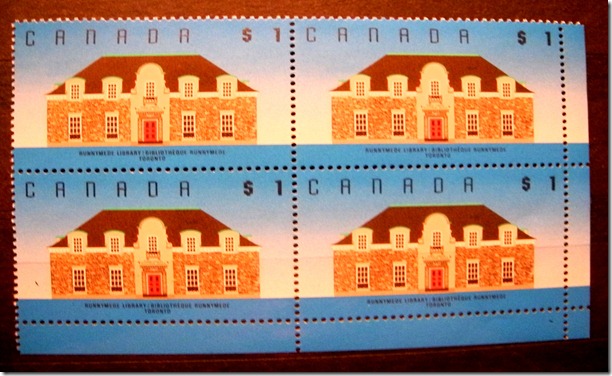
![f1231_it0577a[1] 1930 f1231_it0577a[1] 1930](https://tayloronhistory.com/wp-content/uploads/2013/02/f1231_it0577a1-1930_thumb.jpg)
